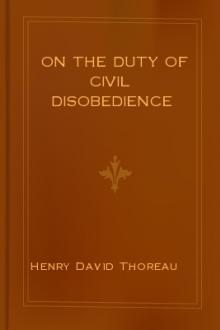Essays Henry David Thoreau (little bear else holmelund minarik .txt) 📖

- Author: Henry David Thoreau
Book online «Essays Henry David Thoreau (little bear else holmelund minarik .txt) 📖». Author Henry David Thoreau
The geographer Guyot observes that the Maranon is three thousand miles long, and gathers its waters from a surface of a million and a half square miles; that the Mississippi is also three thousand miles long, but its basin covers only from eight to nine hundred thousand square miles; that the St. Lawrence is eighteen hundred miles long, and its basin covers more than a million square miles (Darby says five hundred thousand); and speaking of the lakes, he adds, “These vast freshwater seas, together with the St. Lawrence, cover a surface of nearly one hundred thousand square miles, and it has been calculated that they contain about one half of all the fresh water on the surface of our planet.” But all these calculations are necessarily very rude and inaccurate. Its tributaries, the Ottawa, St. Maurice, and Saguenay, are great rivers themselves. The latter is said to be more than one thousand (?) feet deep at its mouth, while its cliffs rise perpendicularly an equal distance above its surface. Pilots say there are no soundings till one hundred and fifty miles up the St. Lawrence. The greatest sounding in the river, given on Bayfield’s chart of the gulf and river, is two hundred and twenty-eight fathoms. McTaggart, an engineer, observes that “the Ottawa is larger than all the rivers in Great Britain, were they running in one.” The traveller Grey writes: “A dozen Danubes, Rhines, Taguses, and Thameses would be nothing to twenty miles of fresh water in breadth (as where he happened to be), from ten to forty fathoms in depth.” And again: “There is not perhaps in the whole extent of this immense continent so fine an approach to it as by the river St. Lawrence. In the Southern States you have, in general, a level country for many miles inland; here you are introduced at once into a majestic scenery, where everything is on a grand scale—mountains, woods, lakes, rivers, precipices, waterfalls.”
We have not yet the data for a minute comparison of the St. Lawrence with the South American rivers; but it is obvious that, taking it in connection with its lakes, its estuary, and its falls, it easily bears off the palm from all the rivers on the globe; for though, as Bouchette observes, it may not carry to the ocean a greater volume of water than the Amazon and Mississippi, its surface and cubic mass are far greater than theirs. But, unfortunately, this noble river is closed by ice from the beginning of December to the middle of April. The arrival of the first vessel from England when the ice breaks up is, therefore, a great event, as when the salmon, shad, and alewives come up a river in the spring to relieve the famishing inhabitants on its banks. Who can say what would have been the history of this continent if, as has been suggested, this river had emptied into the sea where New York stands!
After visiting the Museum and taking one more look at the wall, I made haste to the Lord Sydenham steamer, which at five o’clock was to leave for Montreal. I had already taken a seat on deck, but finding that I had still an hour and a half to spare, and remembering that large map of Canada which I had seen in the parlor of the restaurateur





Comments (0)